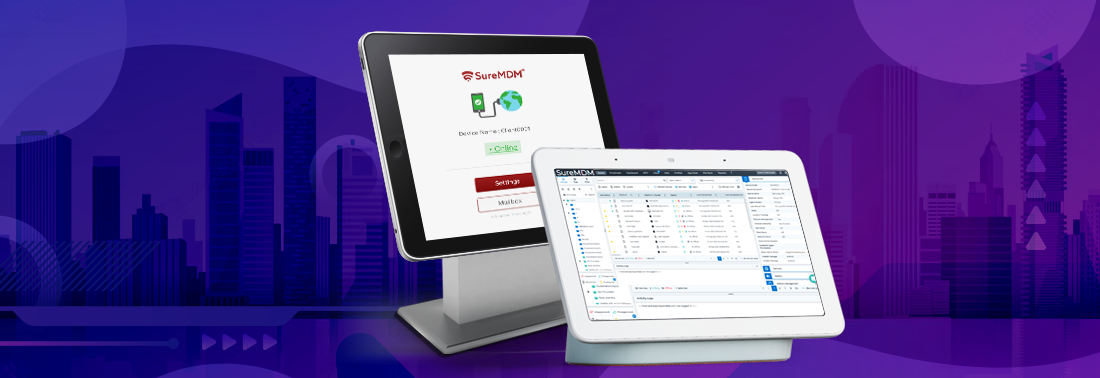4 Pros and Cons Of Using An iPad Digital Signage In Enterprises
Mar 13, 2023 | 42Gears Team
Today, a large number of organizations are using iPads as digital signage displays due to their versatility and ease of use. Digital signage displays are electronic screens that convey information to a specific audience in a particular location. A digital signage display is used to display menus or promotional materials in a restaurant or retail store, information in a museum or airport, and even as wayfinding kiosks in establishments.
iPad digital signs are changing the way businesses interact with their customers. iPads are widely used in industries, such as hospitality and retail, to offer easy assistance to customers. They are often used to entice customers into entering stores. A recent survey found that 8 out of 10 customers entered a store after being attracted by digital signage.
However, to use iPads as digital signage displays only, it is important to lock them down into kiosk mode to avoid distractions. Businesses can easily lock down devices to be used for a specific purpose only using 42Gears’ UEM solution, SureMDM. SureMDM not only simplifies the entire process of converting devices into kiosks but also helps manage them efficiently.
How to Set Up iPad Digital Signage Using SureMDM
Setting up an iPad as digital signage involves several steps:
1. Mount or place the iPad in the desired location: If you plan to use an iPad as a stand-alone digital sign, you'll need to purchase a mount or stand to keep the device securely in place.
2. Connect the iPad to a power source: If the iPad is meant to be used for extended periods of time, you'll need to make sure that it is connected to a power source so that it doesn't run out of battery.
3. Configure the display settings: To ensure that the content on your digital signage is visible from a distance, you'll need to adjust the display settings on the iPad. Go to "Settings" > "Display & Brightness" and adjust the brightness to the maximum level, and set the "Auto-Lock" to "Never" to keep the screen on indefinitely.
4. Install a digital signage app or software: Different apps and software programs, such as a combination of SureMDM and SureVideo, can be used to create, manage, and update the content on your digital signage.
5. Create and upload content: Once you get your digital signage app or software installed, you can begin creating and uploading content to your digital signage. This can include text, images, videos, and other types of media.
6. Configure the security settings: To prevent unauthorized access to the content on your digital signage, you'll need to configure the security settings on the iPad. Go to "Settings" > "Touch ID & Passcode" (or Face ID & Passcode) and set up a passcode to lock the device. Additionally, you can set up a remote management system that allows you to remotely wipe the device if it is lost or stolen.
7. Test the signage: Before going live, make sure to test the signage and double-check the display settings, resolution, and also the content. This will ensure a smooth setup.
Note that this is a general overview, and the steps might differ depending on the software or app you are using. Always check the specific instructions provided by the software provider.
Pros and Cons of iPad Digital Signage Displays
iPads, when used as digital signage displays, have their own set of pros and cons. Here are some of the benefits and disadvantages of using iPads for digital signage:
Pros:
1. Portability: One of the main advantages of using iPads as digital signage displays is their portability. They are small and lightweight, so they can be easily moved around and set up in different locations. This is especially useful for businesses or organizations that need to change their displays frequently or operate in multiple locations.
2. Ease of Use: iPads are user-friendly and easy to operate, even for those who are not particularly tech-savvy. This makes them a good choice for businesses that want to set up and manage their own digital signage without needing to hire a tech-savvy employee or consultant.
3. Flexibility: iPads can be used for a wide range of digital signage applications in various setups. They can also display interactive content such as quizzes, surveys, and games, which can be a great way to engage customers or visitors.
4. Cost-effectiveness: iPads are relatively inexpensive compared to other digital signage options, especially when you consider the cost of hardware, installation, and maintenance. They are also easier to repair or replace if something goes wrong.
Cons:
1. Limited Display Size: One of the main drawbacks of using iPads for digital signage is the display-size. While they are great for small displays or as part of a larger digital signage setup, they may not be the best choice for larger displays where a higher resolution is needed.
2. Short Battery Life: iPads have a relatively short battery life, which can be a problem if they are being used for digital signage in a location where they cannot be easily plugged in. This may necessitate frequent battery replacements or the use of external battery packs, both of which may add to the overall cost of the digital signage setup.
3. Vulnerability to Theft: Because iPads are portable and easy to carry, they are vulnerable to theft. This can be a problem for businesses or organizations that are using iPads for digital signage in high-traffic areas or locations with a high risk of theft.
4. Limited Hardware Options: While a wide range of iPads is available, there are still limitations when it comes to hardware options such as display size, resolution, and processor speed. This can be a problem for businesses or organizations that need specific hardware features for their digital signage setup.
Additional Considerations When Using iPads for Digital Signage
Several factors need to be considered when using iPads for digital signage:
1. Accessibility to Charging Points: iPads need to be charged regularly, so you will need to make sure that you have the necessary arrangements in place to keep them charged and ready for use.
2. Visibility from a Distance: You need to adjust the display settings on the iPad to ensure that the content is visible from a distance and that the screen brightness is high enough to be easily seen in the lighting conditions of the location.
4. App or Software: You need to deploy appropriate software or an app that allows you to easily create, manage, and update the content on your digital signage. This can be a third-party app or custom software.
5. Preventing Unauthorized Access: As iPads are portable devices and can be easily stolen, you need to make sure that you have a plan in place to secure them and prevent unauthorized access to the content on your digital signage. In order to do this, you can use a passcode, Touch ID, or a remote management system that enables you to remotely wipe the device in the event that it is lost or stolen.
6. Network: If you want to manage the content remotely, ensure that the device has a stable internet connection.
7. Durability: Considering the location where your digital signage will be placed and also how often it will be moved, you may need a ruggedized case or enclosure.
8. Software Support: Make sure that the app or software you are using for digital signage is compatible with the current iOS versions and will continue to be supported in the future.
9. Budget: Consider the budget for buying an iPad, the mount, and any other accessories or software.
Conclusion
iPads, when used for digital signage, can provide an engaging experience for your customers and boost your brand’s identity as well. You just need an efficient iPad digital signage solution or enterprise mobility management (EMM) solution, such as SureMDM, that can help you convert your devices into kiosks and assist your IT admins in managing, securing, and monitoring your devices remotely.
iPads can be used for digital signage because of their portability, ease of use, flexibility, and cost-effectiveness. However, they do have some limitations in terms of display size, battery life, vulnerability to theft, and hardware options. Therefore, it is crucial to carefully weigh these advantages and disadvantages before deciding whether iPads are the best option for your digital signage needs.
Are you looking for a solution to convert
your iPads into digital signage?
Subscribe for our free newsletter








